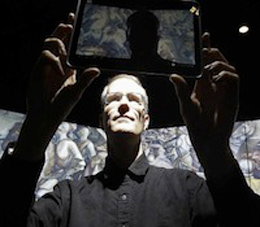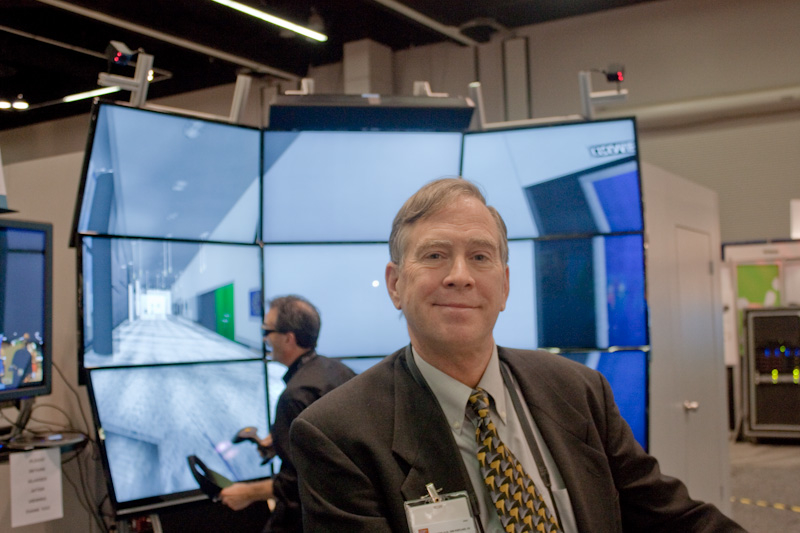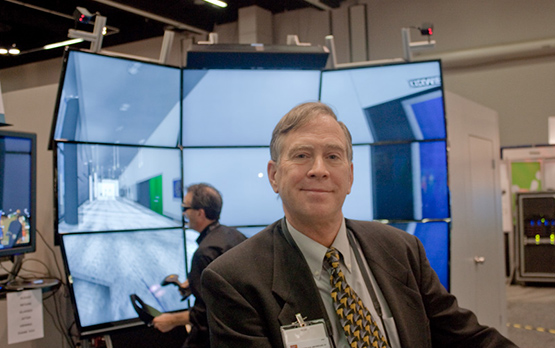
Data Visualization Team at UC San Diego Receives $3.8 Million for SCOPE Project
By:
- Tiffany Fox
Published Date
By:
- Tiffany Fox
Share This:
Article Content

Falko Kuester, profesor of visualization and virtual reality at UC San Diego's Qualcomm Institute, stands in front of the VROOM digital display while viewing data on a tablet computer. The new $3.8 million SCOPE project is the next step in the evolution of digital display technologies at the Qualcomm Institute.
A team of researchers from the University of California, San Diego, has received $3.8 million in grant and matching funds to design and build new 3D display technologies for visualizing big data from macroscopic to microscopic scales.
The project, called SCOPE, is both “an acronym and a visual metaphor for a combined microscope and telescope, enabling users to explore data from the nano to micro to macro to mega scale,” said principal investigator Falko Kuester, a professor of visualization and virtual reality in UC San Diego’s Qualcomm Institute and an associate professor of structural engineering in the Jacobs School of Engineering.
“SCOPE stands for Scalable Omnipresent Environment, which also captures the vision behind the large-scale, ‘walk-in’ collaborative visual computing instrument,” he added. “It’s a Holodeck of sorts that will connect spatially distributed research teams working on big-data challenges.”
The funds for the project include $2.4 million from the National Science Foundation (NSF) Major Research Instrumentation (MRI) program, and an additional $1.4 million in matching funds from UC San Diego, its Jacobs School, and the Qualcomm Institute (the UC San Diego division of the California Institute for Telecommunications and Information Technology, or Calit2), as well as project partners Jackson State University (JSU) and the University of Texas Medical Branch (UTMB).
Kuester says the goal of SCOPE is to create a highly interactive collaboration instrument equipped with a natural human-computer interface that supports advanced 3D modeling and rendering capabilities. The data will be rendered to scales suitable for analyzing large amounts of visual and numerical data pertaining to phenomena of wide dimensions and extreme time scales.

UCSD Research Scientist Thomas A. DeFanti and the NexCAVE, one of the digital display technologies developed at the Qualcomm Institute.
UC San Diego Research Scientist Thomas A. DeFanti, a pioneer in virtual-reality systems, calls SCOPE “the next major evolution in our series of super high-resolution data visualization displays — scores of times higher resolution than HDTV.” DeFanti is a co-PI on the project, along with Tajana S. Rosing, an Associate Professor of Computer Science and Engineering (CSE), and Qualcomm Institute Assistant Research Scientist Jürgen P. Schulze, who is also an Adjunct Assistant Professor in the CSE department.
Over the past 20 years, SCOPE researchers and their partners have designed many of the world’s most advanced visualization display systems, including VizClass, HIPerWall, HIPerSpace, the CAVE, StarCAVE, NexCAVE, TourCAVE, and VROOM.
SCOPE will allow remote collaboration from anywhere in the world. Its 40-100 gigabit/second high-speed networking and embedded flash memory technology — originally developed at the San Diego Supercomputer Center — will make it possible to explore big data interactively and collaboratively, even when the volume of data on display reaches hundreds of terabytes or even petabytes.
SCOPE will eventually connect researchers at UC San Diego with team members at JSU and UTMB. Several years of hands-on workshops at Calit2 with Minority Serving Institutions (MSI)-CyberInfrastructure Empowerment Coalition (MSI-CIEC) led to the partnership with JSU (an MSI) and UTMB.
SCOPE will be used by researchers in disciplines such as structural engineering, computer science, marine science, anthropology, art, health, geo-sciences and bioengineering.
The SCOPE team encompasses 45 researchers from more than a dozen different departments that rely on fundamental computer science visualization research. This set of researchers will be further augmented by: (a) faculty recipients of Calit2 Strategic Research Opportunities (CSRO) grants; (b) graduate students in the NSF-funded Integrative Graduate Education and Research Traineeship (IGERT-TEECH) program for cultural heritage diagnostics and preservation; and (c)undergraduate researchers supported by Research Experiences for Undergraduates (REU) supplements.
IGERT-TEECH served as an inspiration for the SCOPE proposal, tracing its roots back to UCSD Chancellor’s Interdisciplinary Collaboratories Initiative. “It’s a win-win situation,” said Kuester. “This project allows us to develop a truly unique research instrument while building a team of highly interdisciplinary researchers driving innovation through collaboration.”
Share This:
You May Also Like
Stay in the Know
Keep up with all the latest from UC San Diego. Subscribe to the newsletter today.



